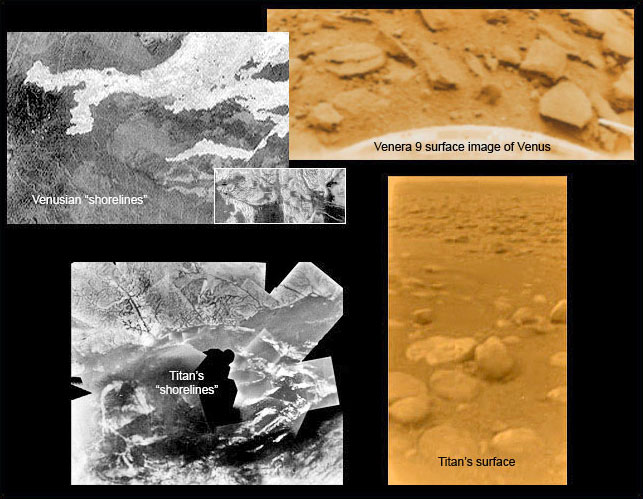|

from
Thuntherbolts Website
Jan 19, 2005

Titan images: NASA/
ESA/ University of Arizona. Venus Magellan image: NASA/JPL
Australian physicist Wallace Thornhill predicted many of the
recently discovered surprising features of Saturn’s moon, Titan. In
June last year he claimed that:
"the moon Titan, which is larger
than the planet Mercury, seems to be a close sibling of Venus. That
Titan may be young is hinted at by its eccentric orbit, which cannot
have persisted for billions of years. So we should be alert to
similarities between Titan and Venus."
See
Cassini’s Homecoming
On December 28, 2004 Thornhill elaborated:
"Under the electric
hypothesis Titan was likely born by electrical expulsion from the
proto-Saturnian brown dwarf. So it should be found to have features
in common with Venus, the planet that shows the most abundant signs
of geologically recent ejection. Already it is known that Titan has
the heaviest atmosphere after its sister, Venus."
His further claims were based on the behavior of electrical
discharges in such a dense atmosphere:
"Titan’s surface features
should also be compared to those of Venus. Scientists tell us that
Titan seems to have been "resurfaced" because there is no evidence
of the expected primordial cratering. The same thing was said about
Venus! Also a radar return from Titan was ’of a type that we would
expect to get back from Venus.’ In the electrical hypothesis, the
similarity would be expected--a heavy atmosphere tends to cause
filamentation of cosmic electrical scars instead of large craters.
Such scars encircle Venus’s equator in the form of
rilles and
spider-web-like formations called ’arachnoids’."
See:
Saturn’s Surprises Will Point to
Electrical Origins
These claims should be easy to falsify. But so far the
electrical
model is the only one to successfully predict what would be found by
the Huygens probe. On today’s report we look at features imaged by the
Huygens probe in its successful descent to the surface of
Titan and
compare them with images of Venus.
At top left we see a radar image of the Venusian surface returned by
the Magellan Orbiter. David Grinspoon, in his book,
Venus Revealed,
interpreted the dark areas in traditional "geocentric" terms:
"The
vast volcanic plains that cover nearly all low-lying areas are the
long-sought global ‘oceans’ on the surface of Venus – frozen oceans
of basalt. One of the most astounding surface forms discovered by
Magellan furthers the analogy: this ocean is fed by rivers! We see
numerous thin, meandering channels, typically a mile wide and up to
thousands of miles in length. [The small inset to the Magellan image
shows an example of the ’river’ channels cut into the white areas.]
On Earth or Mars we would interpret such features as evidence of
past or present running water. The analogy goes quite deep.... We
have had to use a lot of imaginative physics and chemistry to come
up with a suitable model."
Now similar features are being discovered on
Titan [lower left
image]. Traditional interpretations will again require "a lot of
imaginative physics and chemistry." But the electrical scarring
model applies simply to them all. The surface of Venus can be
matched against the surface of Titan, feature for feature.
 The
Huygens probe is believed to have come to rest in the dark area,
or "sea," at the center of
right image. The surface of
the "sea" is solid! At bottom right is the first image returned from
Titan’s surface. For comparison, above it is an image of the Venusian surface returned by the
Russian Venera 9 spacecraft. David Grinspoon again, referring to Venus: The
Huygens probe is believed to have come to rest in the dark area,
or "sea," at the center of
right image. The surface of
the "sea" is solid! At bottom right is the first image returned from
Titan’s surface. For comparison, above it is an image of the Venusian surface returned by the
Russian Venera 9 spacecraft. David Grinspoon again, referring to Venus:
“The immediate impression, of
an eroded field of volcanic rocks, has stood up under decades of
scrutiny.... What would erode and transport fine-grained material on
a planet with no water and almost no winds?”
Emily Lakdawalla,
The
Planetary Society’s Science and Technology Coordinator, had a
similar “immediate impression” of the “eroded field” that Huygens
imaged from the surface of Titan [lower right image]:
"Any geologist
worth her salt thinks of one thing and one thing only when she sees
round rocks: some river of some liquid has rolled broken chunks
around, wearing down their edges, making rounded cobbles. Or, as
United States Geological Survey geologist Larry Soderblom remarked
to me: ’We’ve got rolling stones!’"
But there is another mechanism that creates strewn fields of eroded
rocks on a vast scale. The process of planetary birth and subsequent
electrical interactions during close encounters with other bodies,
as orbits adapt to a new stable configuration, causes deposition of
dust, stones and boulders arriving from space or blasted from
distant parts of the same body. Plasma heating and etching, combined
with "spark" generated "winds," are responsible for rounding the
rocks, scattering them uniformly across the landscape, and leaving
"flow streaks" from electrical "winds." The traditional erosional
mechanisms of blowing gases and flowing liquids require action over
long spans of time to achieve observed effects. Electrical erosion,
resulting from the action of forces that can be billions of times
stronger than mechanical forces, can achieve observed effects in
short times.
Similarity of features is not proof of identity of cause. Further
empirical tests must be devised to distinguish among possible
hypotheses. But this first test--the Huygens close-up observation of
features--verifies the predictions of the electrical hypothesis and
surprises, if not falsifies, traditional explanations.
|

